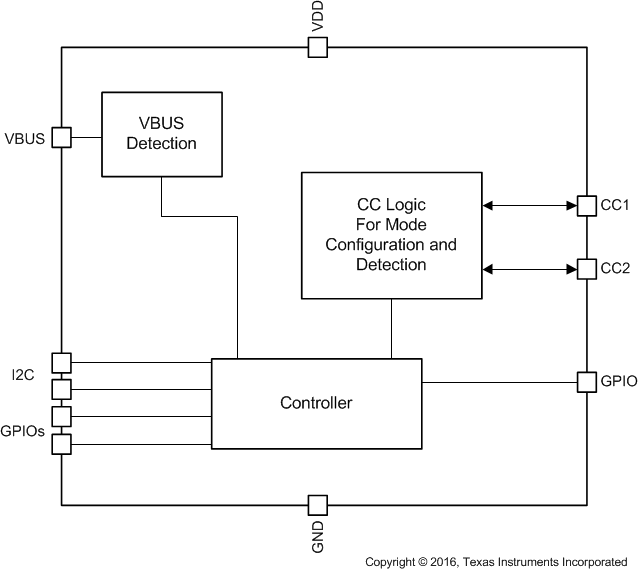SLLSEN9F May 2015 – March 2022 TUSB320
PRODUCTION DATA
- 1 Features
- 2 Applications
- 3 Description
- 4 Revision History
- 5 Pin Configuration and Functions
- 6 Specifications
- 7 Detailed Description
- 8 Application and Implementation
- 9 Power Supply Recommendations
- 10Layout
- 11Device and Documentation Support
- 12Mechanical, Packaging, and Orderable Information
3 Description
The TUSB320 device enables USB Type-C ports with the configuration channel (CC) logic needed for Type-C ecosystems. The TUSB320 device uses the CC pins to determine port attach and detach, cable orientation, role detection, and port control for Type-C current mode. The TUSB320 device can be configured as a downstream facing port (DFP), upstream facing port (UFP) or a dual role port (DRP) making it ideal for any application.
The TUSB320 device alternates configuration as a DFP or UFP according to the Type-C specifications. The CC logic block monitors the CC1 and CC2 pins for pullup or pulldown resistances to determine when a USB port has been attached, the orientation of the cable, and the role detected. The CC logic detects the Type-C current mode as default, medium, or high depending on the role detected. VBUS detection is implemented to determine a successful attach in UFP and DRP modes.
The device operates over a wide supply range and has low-power consumption. The TUSB320 device is available in industrial and commercial temperature ranges.
| PART NUMBER | PACKAGE | BODY SIZE (NOM) |
|---|---|---|
| TUSB320 | X2QFN (12) | 1.60 mm × 1.60 mm |
| TUSB320I | X2QFN (12) | 1.60 mm × 1.60 mm |
 Simplified Schematic
Simplified Schematic Sample Applications
Sample Applications